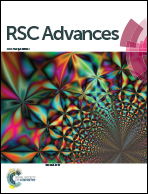Expanding molecular logic capabilities in DNA-scaffolded multiFRET triads†
Abstract
Dynamic rearrangement of DNA nanostructures provides a straightforward yet powerful mechanism for sequence-specific sensing and potential signaling of such interactions. These rearrangements are often interpreted in the context of Boolean logic gates as a means of both reflecting the underlying sensing and providing preliminary processing of the raw data. Here, we expand on previous work to optimize both the sensing and signal transduction of an initial DNA-triad sensor prototype. The core structure of this DNA triad consists of dye-labeled arms connected by 1, 2, or 3 single-stranded DNA linkers, whose presence and length alter the efficiency of Förster resonance energy transfer (FRET) between the dyes. The latter forms the basis for sensing through the use of DNA hybridization and displacement which result in structural rearrangements with each configuration correlated to a different logic state. Three different avenues were pursued to optimize the sensor function: (1) restructuring the connecting linkers and dye-choices in the original structure; (2) changing the mechanism of distance modulation between the arms; and (3) moving the signaling dyes to within the single-stranded portion of the structure. The first approach provided for improvements in FRET properties and the ability to reconfigure and switch the sensors between different types of Boolean logic gates such as going from INHIBIT 1 to Enabled OR by changing dyes, for example. The last approach proved to be the most versatile providing for the largest changes in FRET along with the ability to be repeatedly toggled and reset for multiple sequential sensing events. Switching could be completed in an isothermal manner with a near stoichiometric concentration of inputs and input complements. The continued development and potential applications of these and similar types of DNA sensors are discussed.


 Please wait while we load your content...
Please wait while we load your content...